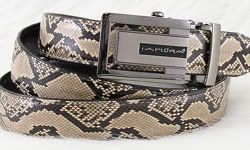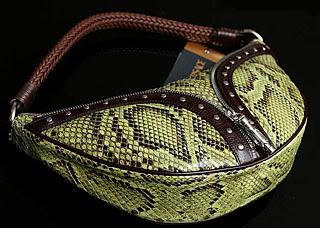Snakes_Incorporated
Not so new Member
Snakeskin Accessories
Snakeskin sells, but details are slippery



Snakeskin is slinking into fashion this fall, showing up on items such as $5,000 Jimmy Choo handbags and $750 Michael Kors belts.
Python, which mostly hails from Southeast Asia and is known for variations in color and scale sizes and a supple feel, is the hottest skin of the season for many luxury-goods makers and designers. Others prefer anaconda, a native of the swamps of tropical South America, which has more regular-sized scales and a slightly plastic texture.
What most consumers don't realize is that no matter which bag or shoes they buy this fall - anaconda or python - they will be taking a position in a global debate over which species of snake is more at risk of being endangered.
In California, one of the world's most important luxury-goods markets, a decades-old state law bans the sale of products made from python. So when the snakeskin look began to take off with the high-end accessories boom a few years back, top designers like Salvatore Ferragamo and Bottega Veneta turned to the anaconda as a substitute for python.
Now, many designers, from Chloe to Michael Kors to Nancy Gonzalez, are producing more accessories with anaconda skins. But that presents another slippery problem: Anaconda is protected by Brazil, which doesn't currently allow commercial harvest and export of the snake.
The result is confusion among shoppers, designers and even animal-protection advocates over which skin is preferable.
"If it's threatened, then I absolutely would not buy it," says Sheri Abelson, a 43-year-old resident of Beverly Hills, Calif., who was shopping at Saks Fifth Avenue. Abelson, like many shoppers on Rodeo Drive recently, had never heard of the dueling restrictions.
Exactly which snake species is more at risk of extinction isn't clear, even to those who study them. It's inherently difficult to count how many snakes lurk in wild swamps, experts say. "For many species, we do not have enough data to know how they are doing and how harvesting would affect them," says Stephen Richter, an assistant professor of biological sciences at Eastern Kentucky University.
Neither of the species used in accessories is on any official endangered-species list. But the Convention on International Trade in Endangered Species says both anaconda and python face extinction if trade isn't monitored closely. The organization forbids participating countries from allowing export unless they have determined that the skin trade wouldn't hurt the species' survival.
Brazil protects the anaconda - which was farmed heavily in the mid-1980s for leather - and hasn't licensed anyone to export the skins.
The popularity of snakeskin this season grew out of the exotic-skin trend that in recent years has made alligator and crocodile accessories must-haves for the high-fashion crowd. Snakeskins cost far less, which is why retailers and designers are pitching them now as more-affordable luxuries appealing to a larger audience. Snakeskin bags and shoes can be roughly half the price of products in alligator and crocodile.
Designers historically have preferred python. Gucci and Dior are pushing python accessories this fall.
Anaconda, on the other hand, "is a much poorer skin," says New York accessories designer Devi Kroell. Still, anaconda has seen a surge in popularity recently as designers use it to get around the California python ban. This fall, Lambertson Truex will sell a variety of anaconda belts and bags.
Anaconda imports into the United States have risen sharply. Last year, about 8,900 skins and products were imported to the United States, up from 5,200 in 2000, according to the U.S. Fish and Wildlife Service.
As demand has risen, so have prices, which roughly doubled in the past five years to $24 per meter for Argentine anaconda.
http://www.abqtrib.com/news/2007/aug/27/sn...s-are-slippery/
Snakeskin sells, but details are slippery



Snakeskin is slinking into fashion this fall, showing up on items such as $5,000 Jimmy Choo handbags and $750 Michael Kors belts.
Python, which mostly hails from Southeast Asia and is known for variations in color and scale sizes and a supple feel, is the hottest skin of the season for many luxury-goods makers and designers. Others prefer anaconda, a native of the swamps of tropical South America, which has more regular-sized scales and a slightly plastic texture.
What most consumers don't realize is that no matter which bag or shoes they buy this fall - anaconda or python - they will be taking a position in a global debate over which species of snake is more at risk of being endangered.
In California, one of the world's most important luxury-goods markets, a decades-old state law bans the sale of products made from python. So when the snakeskin look began to take off with the high-end accessories boom a few years back, top designers like Salvatore Ferragamo and Bottega Veneta turned to the anaconda as a substitute for python.
Now, many designers, from Chloe to Michael Kors to Nancy Gonzalez, are producing more accessories with anaconda skins. But that presents another slippery problem: Anaconda is protected by Brazil, which doesn't currently allow commercial harvest and export of the snake.
The result is confusion among shoppers, designers and even animal-protection advocates over which skin is preferable.
"If it's threatened, then I absolutely would not buy it," says Sheri Abelson, a 43-year-old resident of Beverly Hills, Calif., who was shopping at Saks Fifth Avenue. Abelson, like many shoppers on Rodeo Drive recently, had never heard of the dueling restrictions.
Exactly which snake species is more at risk of extinction isn't clear, even to those who study them. It's inherently difficult to count how many snakes lurk in wild swamps, experts say. "For many species, we do not have enough data to know how they are doing and how harvesting would affect them," says Stephen Richter, an assistant professor of biological sciences at Eastern Kentucky University.
Neither of the species used in accessories is on any official endangered-species list. But the Convention on International Trade in Endangered Species says both anaconda and python face extinction if trade isn't monitored closely. The organization forbids participating countries from allowing export unless they have determined that the skin trade wouldn't hurt the species' survival.
Brazil protects the anaconda - which was farmed heavily in the mid-1980s for leather - and hasn't licensed anyone to export the skins.
The popularity of snakeskin this season grew out of the exotic-skin trend that in recent years has made alligator and crocodile accessories must-haves for the high-fashion crowd. Snakeskins cost far less, which is why retailers and designers are pitching them now as more-affordable luxuries appealing to a larger audience. Snakeskin bags and shoes can be roughly half the price of products in alligator and crocodile.
Designers historically have preferred python. Gucci and Dior are pushing python accessories this fall.
Anaconda, on the other hand, "is a much poorer skin," says New York accessories designer Devi Kroell. Still, anaconda has seen a surge in popularity recently as designers use it to get around the California python ban. This fall, Lambertson Truex will sell a variety of anaconda belts and bags.
Anaconda imports into the United States have risen sharply. Last year, about 8,900 skins and products were imported to the United States, up from 5,200 in 2000, according to the U.S. Fish and Wildlife Service.
As demand has risen, so have prices, which roughly doubled in the past five years to $24 per meter for Argentine anaconda.
http://www.abqtrib.com/news/2007/aug/27/sn...s-are-slippery/





![taramoss_bwcover05[1].jpg taramoss_bwcover05[1].jpg](https://cdn.imagearchive.com/aussiepythons/data/attach/21/21202-taramoss-bwcover05-1-.jpg)
![taramoss_forblackandwhite2[1].jpg taramoss_forblackandwhite2[1].jpg](https://cdn.imagearchive.com/aussiepythons/data/attach/21/21203-taramoss-forblackandwhite2-1-.jpg)
